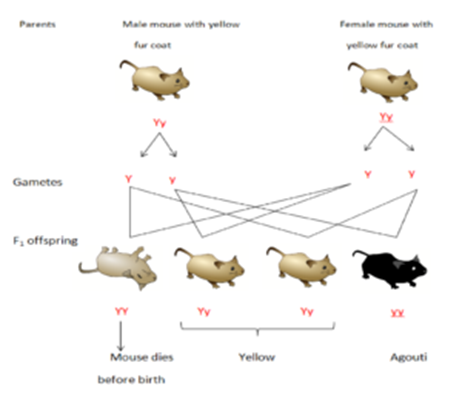Science > Biology > Genetic Basis of Inheritance > Pleiotropy
Mendel performed his experiments with garden pea plant, which has traits or alleles having complete dominance and hence the laws of inheritance were proved. Other scientists performed their experiments on different plants and animals and found deviations to Mendelian ratios. Depending upon these experiments and observations, a different pattern of inheritance called gene interactions was discovered. This study is known as Post – Mendelian genetics or Neo-Mendelian genetics. In this article, we shall study the concept of pleiotropy and its effects.
The phenomenon of controlling more than one character at the same time is called pleiotropy or pleiotropism. Such genes are called pleiotropic genes. These genes produce more than one phenotypic effect which is totally unrelated. The pleiotropic effect is produced by a gene owing to a cascade (succession) of reactions during some metabolic pathway which is influenced by the original gene product and contributes to different phenotypic effects. The ratio is 2:1 instead of 3:1
Examples: In the pea plant, the same gene that affects the colour of the flower also influences the colour of the seed coat and the colour of the leaf axil. The gene that determines the size of the wings in Drosophila also affects its eye colour, the position of dorsal bristles, the shape of the spermatheca, fertility and length of life.
Effects of Pleiotropy in Human Beings:
Phenylketonuria (PKU):
Phenylketonuria also called PKU, is a rare inherited disorder that causes an amino acid called phenylalanine to build up in the body. PKU is caused by a defect in the gene that helps create the enzyme needed to break down phenylalanine.
Phenylketonuria is an autosomal recessive character controlled by a mutant gene present on the 12th chromosome. This mutant gene fails to code for the enzyme phenylalanine hydroxylase (PAH) required for normal metabolism of amino acid phenylalanine to tyrosine. Due to this, there is an accumulation of amino acid phenylalanine in the body fluids such as blood, sweat, and cerebrospinal fluid. An abnormal breakdown product phenyl ketone is found in urine. A higher level of phenylalanine and breakdown product phenyl ketone causes severe brain damage leading to mental retardation.
Symptoms: A musty odor in the breath, skin or urine, caused by too much phenylalanine in the body, neurological problems that may include seizures, skin rashes (eczema), fair skin and blue eyes, because phenylalanine can’t transform into melanin — the pigment responsible for hair and skin tone, abnormally small head (microcephaly), hyperactivity, intellectual disability, delayed development, behavioral, emotional and social problems, psychiatric disorders
Inheritance: For a child to inherit PKU, both the mother and father must have and pass on the defective gene. This pattern of inheritance is called autosomal recessive. If only one parent has the defective gene, there’s no risk of passing PKU to a child, but it’s possible for the child to be a carrier. Most often, PKU is passed to children by two parents who are carriers of the disorder but don’t know about it.
Marfan or Morphan’s Syndrome:
Marfan syndrome is a genetic disorder that affects the body’s connective tissue. Connective tissue holds all the body’s cells, organs and tissue together. It also plays an important role in helping the body grow and develop properly.
It is caused by a pleiotropic gene which is characterized by a slender body, limb elongation, hypermobility in joints, lens dislocation and a tendency to develop heart diseases. Marfan syndrome does not affect intelligence.
Marfan syndrome is caused by a defect in the gene that enables your body to produce a protein that helps give connective tissue its elasticity and strength. Most people with Marfan syndrome inherit the abnormal gene from a parent who has the disorder. In about 25 percent of the people who have the Marfan syndrome, the abnormal gene doesn’t come from either parent. In these cases, a new mutation develops spontaneously.
Sickle Cell Anaemia:

The gene Hbs (recessive) is responsible for disease sickle cell anaemia. A normal or healthy gene is HbA .which is dominant. Thus disease carrier having heterozygotes HbA / Hbs show signs of mild anaemia as their R.B.C.s become sickle-shaped (half-moon) and their oxygen-carrying capacity decreases. But can live a normal life. But the homozygotes with recessive gene Hbs die of fatal anaemia. A gene which causes death of the bearer is called a lethal gene. Two carrier parents will produce normal, carriers and sickle cell anemic children in 1:2:1 ratio.

Effect of the Pleiotropy in Mice:
Mice were first used for genetics research by the French biologist Lucien Cuénot in 1902. His breeding experiments showed that three mnemons (genes), allowed the production of one chromogen (pigment) and two distases (enzymes). The combination of the chromogen and one of the enzymes produced either a black or yellow colour in the mice. If there was no chromogen the mouse was albino. He showed mice inherited these coat colours in the ratio 3:1 as predicted by Mendel’s inheritance laws.
In 1905 Cuénot discovered the first lethal genetic mutation in the mouse. Lethal gene in mice causes death at an early stage of development, often before birth. The effect of the lethal gene is illustrated by the inheritance of fur (coat) color in mice,

In mice, yellow fur is dominant over non-yellow fur color. A cross was made between two heterozygous yellow fur mice (Yy and Yy) and F1 generation was obtained. The cross is supposed to produce offsprings like 1 YY genotype, 2 Yy genotype, and 1 yy genotype.
The dominant homozygous organism with yellow fur color (YY) will never survive. The dominant homozygous organism dies in the embryonic stage because of a lethal combination. Hence the ratio 3:1 ratio changes to 2:1. It is a modified monohybrid ratio. Therefore, all living yellow fur mice are heterozygous(Yy). Here, gene ‘Y’ is recessive in relation to its effect on viability but dominant in relation to fur color.
Lethal Genes:
Sometimes, the pleiotropic gene effect may produce various abnormal phenotypic features which are collectively called syndromes.
If the effects of the pleiotropic gene become the cause of the death of an individual, then the pleiotropic gene is called the lethal gene. The lethal genes cause a great deviation from the normal development of an individual. Hence, that individual does not survive. As a result of the lethal effect, Mendel’s monohybrid ratio of 3:1 gets modified and changed into 2:1. This lethal gene is seen either in the homozygous dominant condition or homozygous recessive condition.
One reply on “Pleiotropy”
Amazingly explained theory..love frm Kashmir..mam /sir